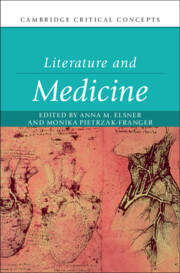Book contents
- Literature and Medicine
- Cambridge Critical Concepts
- Literature and Medicine
- Copyright page
- Dedication
- Contents
- Figures
- Contributors
- Acknowledgements
- Medico-Literary Pathways, Crossroads, and Side Streets
- Part I Origins: Histories
- Part II Developments: Forms
- Chapter 6 Illness and the ‘Fall’ of Language
- Chapter 7 Translating Chronic Pain and the Ethics of Reading in the Personal Essay
- Chapter 8 Physician-Poets and Vitalist Theories of Life
- Chapter 9 Healthcare Anecdotes and the Medically Anecdotal
- Chapter 10 Literary Realism and Mental Breakdown
- Chapter 11 Time and Narrative in the Age of Postnatural Death
- Chapter 12 Performance and/as Contagion in the Time of the COVID-19 Pandemic
- Chapter 13 The Parallel Chart as Medico-Literary Practice
- Chapter 14 Articulating the Experiential in Graphic Medicine
- Part III Applications: Politics
- Afterword
- Index
Chapter 14 - Articulating the Experiential in Graphic Medicine
from Part II - Developments: Forms
Published online by Cambridge University Press: 17 January 2024
- Literature and Medicine
- Cambridge Critical Concepts
- Literature and Medicine
- Copyright page
- Dedication
- Contents
- Figures
- Contributors
- Acknowledgements
- Medico-Literary Pathways, Crossroads, and Side Streets
- Part I Origins: Histories
- Part II Developments: Forms
- Chapter 6 Illness and the ‘Fall’ of Language
- Chapter 7 Translating Chronic Pain and the Ethics of Reading in the Personal Essay
- Chapter 8 Physician-Poets and Vitalist Theories of Life
- Chapter 9 Healthcare Anecdotes and the Medically Anecdotal
- Chapter 10 Literary Realism and Mental Breakdown
- Chapter 11 Time and Narrative in the Age of Postnatural Death
- Chapter 12 Performance and/as Contagion in the Time of the COVID-19 Pandemic
- Chapter 13 The Parallel Chart as Medico-Literary Practice
- Chapter 14 Articulating the Experiential in Graphic Medicine
- Part III Applications: Politics
- Afterword
- Index
Summary
Graphic Medicine enriches and expands the field of Medicine and Literature by providing an additional, visual, modality for understanding stories of illness and well-being. Combining words and pictures, the hybrid medium of comics engages both left and right hemispheres of the brain, which can lead to more immediate, intuitive, and complete comprehension for the reader/viewer than text alone. This essay briefly addresses the origins and commitments of Graphic Medicine and illuminates, through Visual Thinking Strategies, why and how comics are particularly effective in the domains of clinical medicine and medical ethics – that is, for healthcare providers and medical learners, and for patients as well.
Keywords
- Type
- Chapter
- Information
- Literature and Medicine , pp. 238 - 260Publisher: Cambridge University PressPrint publication year: 2024

